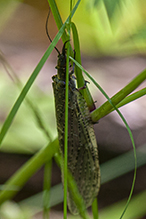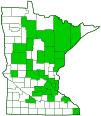Spring fishfly
(Chauliodes rastricornis)
Conservation • Description • Habitat • Ecology • Distribution • Taxonomy
Conservation Status |
|||
| IUCN Red List | not listed |
||
| NatureServe | NNR - Unranked |
||
| Minnesota | not listed |
||
Description
Spring fishfly is a large, short-lived, primitive-looking, winged insect. It occurs in the United States and southern Canada east of the Great Plains. It is common in Minnesota. Larvae are found in a variety of aquatic habitats, including ponds, swamps, marshes, and springs. They take one to five years to reach maturity. They feed on both algae and small invertebrates, including crustaceans, clams, worms, and other insects. Adults are found from late May to early July near larval habitats. They live only a few days to a week. They are active at dusk but remain hidden during the day. It is thought that they do not feed, though they have been collected in moth traps.
Adults are brownish-gray, 1⅜″ to 2″ (35 to 50 mm) in length, and have a wingspan of 2½″ to 3⅛″ (63 to 80 mm).
There are two large compound eyes on the sides of the head and three small simple eyes (ocelli) in a triangle on top of the head. The antennae are long, dark brownish-gray, and have many segments. On the female they are serrated on one side, with a short, saw-like tooth on each segment. On the male they are comb-like, with a long branch on one side of each segment (pectinate). The mouthparts are adapted for chewing. The jaws (mandibles) on both sexes are always shorter than the length of the head. The back of the head (occiput) is brownish-gray with dark brown to black markings. On each side of the occiput there is a blotchy stripe in the middle (middorsal), a stripe on each side, and four short streaks between.
The thorax has three segments. It is brownish-gray with dark brown to black markings and a few small yellow spots. The first segment (prothorax) is rectangular and slightly narrower than the head. It is brownish-gray above with dark brown to black markings, including a large dark spot on each side.
The abdomen has ten segments. When viewed from the side the anal plate on the last segment is triangular.
The wings are delicate and very long, much longer than the body. They are clear and tinted pale brown, with no dark or white markings apart from the veins. The veins on the forewing are dark interrupted with white, appearing irregularly dashed. There are many slender cross veins near the leading edge (costal area). The media (M) vein has two branches, both of which reach the wing margin.
The hindwings are pleated, allowing them to be folded over the abdomen when at rest. The veins are mostly medium brown. Only the vein on the leading edge (costal margin) is dashed dark and white like the forewing.
The legs may be mostly yellowish or entirely dark. The last part of the leg (tarsus), corresponding to the foot, has 5 segments and is always dark. The The fourth tarsal segment is cylindrical, not dilated.
Size
Total length: 1⅜″ to 2″ (35 to 50 mm)
Wingspan: 2½″ to 3⅛″ (63 to 80 mm)
Similar Species
Habitat
A variety of aquatic habitats, including ponds, swamps, marshes, and springs
Ecology
Season
Late May to early July
Behavior
Adults are active at dusk but remain hidden during the day. The wings are held roof-like and to the side of the abdomen when at rest. They are relatively weak fliers.
Life Cycle
The larva takes 1 to 5 years to reach maturity. After reaching maturity, it crawls onto land and pupates in moist soil under a log or rock. Adults emerge in the spring and live only a few days to a week.
Larva Food/Hosts
Algae and small invertebrates, including crustaceans, clams, worms, and other insects.
Adult Food
Adults do not feed.
Distribution |
||
|
Sources Biodiversity occurrence data published by: Minnesota Biodiversity Atlas (accessed through the Minnesota Biodiversity Atlas Portal, bellatlas.umn.edu, 10/2/2025). |
|
| 10/2/2025 | ||
Occurrence |
||
Common in Minnesota |
||
Taxonomy
Order
Megaloptera (alderflies, dobsonflies, fishflies)
Family
Corydalidae (dobsonflies and fishflies)
Subfamily
Chauliodinae (fishflies)
Genus
Chauliodes (spring and summer fishflies)
Subordinate Taxa
Synonyms
Chauliodes denticornis
Hermes indecisus
Common Names
spring fishfly
toothed-horned fish-fly
Glossary
Costal margin
The leading edge of the forewing of insects.
Occiput
The back of the head. In Odonata, Megaloptera, and Neuroptera, the upper part of the head behind the eyes.
Ocellus
Simple eye; an eye with a single lens. Plural: ocelli.
Tarsus
On insects, the last two to five subdivisions of the leg, attached to the tibia; the foot. On spiders, the last segment of the leg. Plural: tarsi.
Visitor Photos
Share your photo of this insect.
This button not working for you?
Simply email us at info@MinnesotaSeasons.com.
Attach one or more photos and, if you like, a caption.
|
||
MinnesotaSeasons.com Photos
 |

Slideshows

Visitor Videos
Share your video of this insect.
This button not working for you?
Simply email us at info@MinnesotaSeasons.com.
Attach a video, a YouTube link, or a cloud storage link.
Other Videos
Spring Fishfly (Chauliodes Rastricornis)
Random Bugs I Find
Spring Fishfly (Corydalidae: Chauliodes rasticornis) Female
Carl Barrentine
Chauliodes rastricornis
DocBebitte

Visitor Sightings
Report a sighting of this insect.
This button not working for you?
Simply email us at info@MinnesotaSeasons.com.
Be sure to include a location.
MinnesotaSeasons.com Sightings

